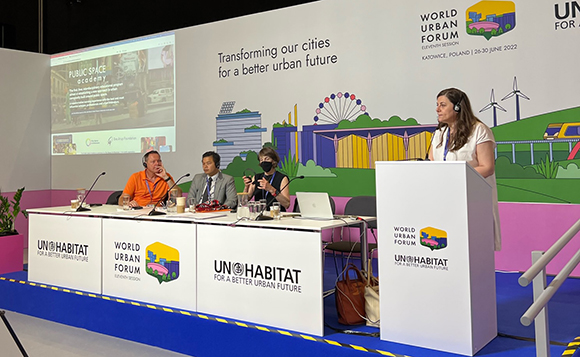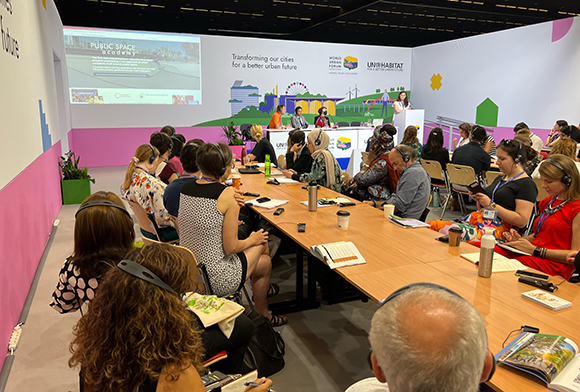City Space Architecture launching the Public Space Academy at WUF11 in Katowice

.
Launch of the Public Space Academy at the 11th World Urban Forum in Katowice, coordinated by our Founder and President Dr Luisa Bravo (on the right) with (from left to right) Prof. Hendrik Tieben (CUHK), Mr. Jose Chong (UN-Habitat) and Prof. Setha Low (CUNY, the Graduate Center).
.
During the 11th World Urban Forum in Katowice, City Space Architecture launched the Public Space Academy, the first, free, interdisciplinary educational program entirely dedicated to public space knowledge for the design and implementation of effective solutions with community impact. The Academy is developed in cooperation with the Ove Arup Foundation, with the generous contribution of UN-Habitat. It will start in 2023 as an online and open initiative and will provide introductory and advanced training on public space, engaging the best and most influential scholars, professionals, and urban innovators, from different backgrounds and expertise. It will be developed as a Massive Open Online Course (MOOC) and all contents will be available for free on a customized OpenEdX platform. Online contents will be complemented with several face-to-face activities, such as talks, public dialogues, meetings, workshops, and exhibitions, in different cities worldwide, engaging Universities, cultural institutions and NGOs affiliated to City Space Architecture’s global network.
The Public Space Academy is aimed at inspiring and empowering a new generation of urban thinkers and doers who are willing to become agents of change in their own cities and communities.
.
Visit the website of the Public Space Academy
.
The training event at WUF11 titled Public Space Academy: a transformative learning experience for a new approach to urban complexity built around public space was a preview of the contents that will be included in the online training of the Public Space Academy, such as:
- introduction to public space complexity and the need for mature and interdisciplinary analytical skills for academic research and for effective design
- definition a comprehensive urban strategy for local implementation, that is built around humans and their life in the public domain, putting public space as a priority in the regional and local urban agenda.
The training event, attended by more than 50 participants, was divided in three parts, all moderated by our Founder and President Luisa Bravo.
.
First part: Theoretical introduction: why public space matters
Setha Low, The Graduate Center, City University of New York
Hendrik Tieben, School of Architecture, The Chinese University of Hong Kong
Jose Chong, UN-Habitat
.
Key points:
- theoretical understanding of public space requires critical thinking on the public domain components: a) Social Justice and Democratic Practices; b) Health, Well-being, and Resilience; c) Play, Recreation, and Creativity; d) Informal Economy and Social Capital; e) Environmental and Ecological Sustainability; f) Cultural Identity and Place Attachment
- current threats to public space are: a) lack of representation (erasure of local history; loss of cultural symbols; restoration without social functions); b) social injustice (unfair distribution of space; lack of procedural justice; lack of recognition of differences); c) privatization (economic incentives for funding and design; controlled access; exclusive events and expensive activities; over regulation) d) securitization (policing, surveillance, CCTV, bollards and barriers, racial and cultural profiling)
- the COVID-19 pandemic has highlighted the crucial importance of public space in regard of: a) Realizing our Responsibilities towards People & Planet; b) Keeping and Improving our Physical & Mental Wellbeing; c) Fostering Common Prosperity; d) Engaging in Carbon-free Mobility; e) Reconnecting with People and Build a Sense of Community
- in the current COVID-19 context and the imminent need for climate change adaptation & resilience, cities and countries are required redefining their agendas and develop a new strategic framework, placing public spaces as a key driver of change.
.
Second part: Tools and methodologies for public space implementation
Setha Low, The Graduate Center, City University of New York
Sara Candiracci and Dasha Moschonas, ARUP
Riccardo Conti, Catalytic Action
Chiara Martinuzzi, UN-Habitat
.
Key points:
- public space design requires in-depth observations and understanding from an ethnographic point of view, in regard of everyday life and culture – Recommended: Toolkit for the Ethnographic Study of Space (TESS)
- the design of child-friendly public spaces requires to reconsider: traffic and pollution; high-rise living and urban sprawl; crime, social fears and risk aversion; inadequate and unequal access to the city, and has the potential to act as a unifying theme to navigate complex challenges, such as: health and wellbeing; local economy; safety; stronger communities; nature and sustainability; climate resilience; a catalyst for improving cities - Recommended: Proximity of Care Design Guide; Playful Cities Toolkit;
- when children are affected by displacement public space can be a driver to improve social cohesion, ownership and belonging through a co-design process, it has a positive impact on the local economy, by hiring local labourers, adopting context-appropriate technologies and purchasing local materials, and can deliver better infrastructure for the whole community – Recommended: Handbook DeCID
- involving girls and women in urban development will make public space and the whole city better for everyone, becoming more inclusive, equal and sustainable – Recommended: Her City Toolbox
.
Third part: Public hearing simulation
Michelle Pannone, Marywood University
Rozina Spinnoy, BIDs Belgium
.
Attendees were engaged in a public hearing simulation: they performed as stakeholders in a role play for a simulated participatory event and discussed the “how to” dimension for the implementation of a large-scale urban transformation with a specific focus on public space.
.

.
Thank you to all participants who attended our training event.
Subscribe to the newsletter of the Public Space Academy!
.
.
Comments and feedbacks from the training event
Declared actions/action-oriented recommendations/ways forward from the discussions for the Implementation of the New Urban Agenda (key points only)
- public space is a crucial asset for sustainable and resilient development, both as a top-down/expert-led activity and as a bottom-up/citizen-led practice, and must be included as a priority in regional and local agenda
- public space is not merely a design activity related to landscape urbanism, but it is more and more involved in a technical and political process dealing with land use, environment, infrastructure networks, social issues and policy making, in response also to global trends such as massive urbanization, privatization and gentrification
- inclusive public space design requires to consider context-dependant temporary and permanent solutions for long-term impact and a multiplicity of users and needs
- multi-scale and multi-stakeholders approach creates the greatest impact for community quality of life using public space as a social infrastructure
- public space implementation requires a monitoring strategy for maintenance and adaptation to daily uses and appropriation from different social groups.
.
What transformative ideas/actions were highlighted that could help to accelerate progress towards the SDGs, the Paris Agreement (Climate), the Global Compacts on Migration and Refugees
- define a strong public-private-people partnership as a powerful instrument to design and implement public spaces for all, fostering social cohesion and intergenerational exchange
- a fair spatial distribution of public space can enhance human coexistence, considering cultural diversity and regional heterogeneity, strengthening civic and democratic participation with particular attention to less advantaged social positions and vulnerable groups
- inclusive public life can redefine citizenship and social integration, through the design and management of proper and inclusive public spaces
- the design of public space should consider resilient, climate-responsive and nature-based solutions integrated with sustainable and soft mobility
.
Which impact or dynamics in the implementation of the New Urban Agenda have been identified in your event?
- an effective public space city-wide strategy adopting an integrated and iterative approach can protect and regenerate the public realm for a sustainable future, improving the access of high-quality public spaces to the most vulnerable groups
- well-designed and well-managed public spaces can provide opportunities for formal and informal economies by attracting investments, entrepreneurs, and services, enhancing the value of land and property, redefining urban environments with human vibrancy and livelihood, encouraging walking, cycling and play, and improving physical and mental health.
.
Which concrete actions towards the implementation of the New Urban Agenda have been identified in your event? At a national level? Subnational? Regional? Global?
The event was the opportunity to launch a new educational program, the Public Space Academy, aimed at promoting a new approach to urban complexity built around public space, both in terms of design and implementation. The Academy will establish a collaborative learning environment for the exchange of theoretical contents and the design of practical solutions. The Academy will be instrumental to:
- learn how to tackle urban and social issues and define priorities for public space design
- acquire expertise to present and discuss reasons and objectives of a public space strategy integrated in local, regional and national policies
- develop skills on peer-to-peer learning, teamwork and action research activities
.
.

.